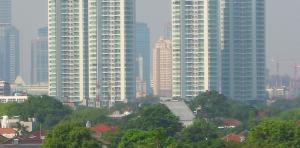High Density Compact City is touted as the model for sustainable living. Planners envisage smaller, high density cities that will reduce the spatial extension of cities; create places where people can live closer to work, relying less on environmentally damaging methods of transportation, and reducing the collective carbon footprint.
This latest model of planning arose as a critique of the superfluous approach to city planning adopted by the proponents of the Garden City Movement; under which rapid development resulted in urban sprawl causing increased car-dependency and irreparable environmental damage. Proponents of compact cities, such as Jane Jacobs, have long argued that compact and high density configurations yield the critical mass of people that is capable of supporting businesses, better infrastructures and more vibrant communities.



The Compact City model promises to solve many if not these issues and even enhance our quality of life in the city. It is a model that is relatively realistic with regards to population expansion and it is strongly anchored in the economics of agglomeration. It functions on the basis that the higher the population density confined in a small space, the lower the budget for transportation infrastructures (public transport, parking, roads etc…). The close proximity also allows the easy provision of efficient waste, water and electrical infrastructures. In addition, close proximity will allow both businesses and residents to better reap the fruits of agglomeration saving on transport cost and time while benefiting from the best services. These massive savings will then be re-channeled in upgrading facilities and enhancing living quality.
As compared to previous planning models, the compact city model does not attempt to consciously limit the population of a certain area, it is by default a high-density development. Nor does it persist in defining and segregating zones of activities. The limited availability of land calls for a mixed-use approach with a mixed of commercial, residential, institutional and recreational facilities. Zoning if it is still applied may no longer be planar.
However, with such reductions in land-take in mind and the continued migration of the population from rural to urban areas, it is expected that building and people density at the heart of the city will more-or-less double in the next few decades. How will our planners deal with this sudden influx? Are out cities ready for the Compact City model?
As concerned citizens, unless this model is proven, we have the rights to doubt the above-mentioned promises . Growing cities such as Mumbai, Delhi, Jakarta and Brasília are currently struggling to cope with their current population influx, suffering from over-crowdedness, lack of basic facilities and infrastructures, rising crime rate leading to insecurity and insufficient housing all of which are further exacerbated by relic administrative procedures, political and social turmoil, and above all, the inability to realistically predict their future situation. However, we should also recognize that these cities were not ready and now face difficulties to adapt to that kind of density.
The Compact City poses itself as a resilient model capable of adapting to sudden economic and demographic fluctuations. However, to prepare for such drastic changes, growing cities need realistic planning. Being realistic in the forecast of population is a key element in the success of planning. The lack of clear vision and the ability to foresee and plan for realistic growth is what has hindered the ability of these cities to adapt. Realistic figures are required to help define priorities and prevent incoherent piece-meal development.

